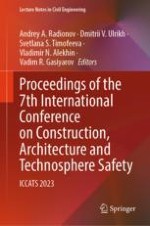This book highlights recent findings in civil and environmental engineering and urban planning, and provides an overview of the state of the art in these fields, mainly in Russia and Eastern Europe. A broad range of topics and issues in modern engineering are discussed, including construction, buildings and structures, advanced materials, innovative technology, methods and techniques in civil engineering, heating, gas supply, water supply and sewerage, foundation engineering, BIM, structural reliability, durability and monitoring, special and unique structures construction (bridge, tunnel, road, railway engineering), design and construction of hydraulic structures, concrete engineering, urban regeneration and sustainable development, urban transport system, engineering structure safety and disaster prevention, water resources engineering, water and wastewater treatment, recycling and reuse of wastewater, etc. The volume gathers selected papers from the 7th International Conference on Construction, Architecture and Technosphere Safety (ICCATS), held in Sochi, Russia in September 2023. The authors are experts in various fields of engineering, and all papers have been carefully reviewed.
